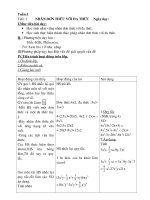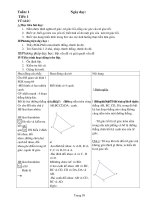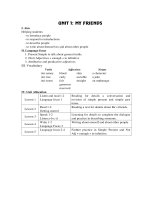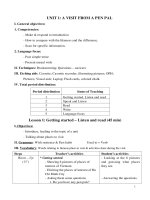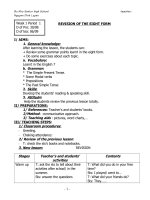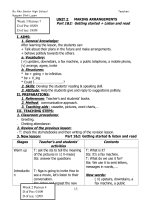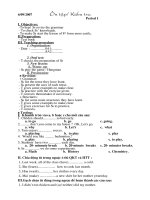Giáo án anh 8 HKI
Bạn đang xem bản rút gọn của tài liệu. Xem và tải ngay bản đầy đủ của tài liệu tại đây (617.55 KB, 67 trang )
Teaching date: Sep. 5th 2004
Week 1 Period: 1
Introduction
of English 8
A. Aims: To introduce English 8 student's book and curriculum.
B. Objective: By the end of the lesson, Ss will be able to hold their English 8
book and curriculum.
C. Preparation: Handout.
D. Procedure:
1. Greeting: T makes friends with students by introducing name and greeting
them.
2. Introduce:
2.1. Method of English:
- T says s.t about method of learning English at school and at home.
- Ss can ask some questions.
- T says some her requirements. (school things, notebooks ...)
2.2. Student's books:
- Ss are divided into 8 groups of 6.
- T uses handout to give questions.
1. How many units are there in the books? Give their
topics.
2. How many parts does each unit have? What are
they?
3. Say the difference between unit of English 7 book
and English 8 book.
4. What part begins each unit? And what part ends?
5. What part has exercises? Where is it?
- Ss discuss in groups.
Feedback:
3. Homework:
- Look at the pictures of Unit 1.
Teaching date: Sep. 5th 2004
Unit one: My friends
Period: 2
Getting started. Listen and Read
A. Aim:
To introduce structures:
- What do / does ........ look like?
- (not) adjective + enough + to do s.t.
To review Exclamatory Sentences "What".
B. Objective: By the end of the lesson, Ss will be able to use structures have just
been studied to talk about their friends fluently.
C. Preparations: Pictures; Wordcards; Poster.
D. Procedure:
1. Warmer: Getting started
- T asks Ss to give their activities in the summer holidays, then write them
on the board.
- Pictures are put on the board and Ss answer the questions.
1/ What are they doing?
2/ What are the girls doing?
3/ What are your favorite activities in the free time?
4/ Do the girls in our school play soccer?
5/ Do you play soccer / volleyball after school?
6/ Do you play the chess at recess?
2. Pre-teach vocabulary:
(to) seem + adj. VNese
(to) look like VNese
enough (adv.)
Check understanding vocabulary: RO & R
3. Presentation: Listen and Read
3.1. Set the scene:
- Some questions about Hoa are given.
- T introduces the content of the dialogue.
Hoa talks with Lan and describes her friend Nien to Hoa.
3.2. Presentation:
- T reads the dialogue.
- Ss listen then repeat it.
- Ss answer the questions in pairs.
Feedback:
- T elicits the T.L 1.
What does she look like?
She is beautiful.
Concept check:
* Meaning:
* Form: What + do/does + S + look like?
S + be + adj.
* Use:
- T uses wordcards to give cues.
1/ He / intelligent.
2/ The girls / pretty.
3/ The boy / smart.
- Ss practise in chorus, in groups, in pairs.
Delayed correction
- T elicits the T.L 2
She wasn't old enough to be in my class.
Concept check:
* Meaning:
* Use:
* Form: S + (not) be + adj. + enough + to inf.
- Poster is stick on the board.
1/ She / not old / see that film.
2/ His children / smart / finish this work.
3/ You / not old / to drive motorcycle.
- Ss do in individual.
Feedback:
3.3. Production: Mapped Dialogue
Nam
- Hello….
- …. received …..Hung…
- …..intelligent.
- ….not old … . He is 12.
His friend
- …. seem happy.
- what ……..like?
- Was …….. classmate?
4. Homework:
- Answer the question.
- Remember and rewrite the short dialogue
Teaching date: Sep. 7th 2004
Unit one: My friends
Period: 3
Speak + listen
A. Aim: To describe someone
To introduce someone and answer after being introduced.
B. Objective: By the end of the lesson, Ss will be able to describe appearance, to
listen to the introduction and answer after being introduced.
C. Preparations: Pictures; Photographs; Posters.
D. Procedure:
1. Warmer: Wordstorm
Build Hair/ Eyes …
2. Pre-teach vocabulary:
- T uses pictures to elicit new words
Slim (adj.)
Straight (adj.)
Bald (adj.)
Curly (adj.)
Fair (adj.)
Check understanding Vocabulary: RO & R
3. Speak:
3.1. Pre-speaking:
- T reads the dialogue.
- Ss read it in chorus, in pairs
3.2. While-speaking: Guessing Game
- T uses pictures to give cues.
- T runs through the cues.
- T models:
T: He is thin and tall. He has short back hair.
Ss: Is this Van?
T: Yes.
- Ss practise in open pairs, in chorus, in closed pairs.
Delayed correction:
3.3. Post-speaking:
- Some pictures of famous people ( Hång S¬n, Huúnh §øc, Mü T©m)
are stick on the board.
- Ss describe them in groups of 6. (Use extra board)
Feedback:
4. Listen:
4.1. Pre-listening:
- Ss read pattern sentences in the box.
- T helps Ss to understand their meaning.
- Ss read the dialogue, then guess positions of the pattern sentences in
the dialogues in pairs.
Feedback:
4.2. While-listening:
- Ss listen 3 times.
The 1st to hold the information.
The 2nd to fill the gaps.
The 3rd to check their work in the pre-listening.
- Ss read the dialogue.
4.3. Post-listening: Role play
5. Homework:
- Rewrite the dialogues.
- Describe Ss' parents.
Teaching date: Sep. 11th 2004
Unit one: My friends
Week 2 Period: 4
Read
A. Aim: Reading for specific information
B. Objective: By the end of the lesson, Ss will be able to know more about Ba's
friends.
C. Preparations: Poster.
D. Procedure:
1. Warmer: Role play
- 2 Ss go to the board and to play the roles based on the dialogues in
listening part
2. Pre-teach vocabulary:
a character VNese
an orphanage explanation
reserved (adj.) VNese
sociable (adj.)
(to) tell jokes explanation
sense of humor VNese
Check understanding: RO & R
3. Pre-reading: T/F Statements prediction
- T introduces the content of the text.
- T sticks the poster on the board.
1/ Ba only has 3 friends: Bao; Song; Khai.
2/ Ba and his friends have the same characters.
3/ Bao; Song; Khai are quite reserved in public.
4/ They all enjoy school and study hard.
- T runs through sentences.
- Ss do in pairs.
Feedback:
4. While-reading:
4.1. T/F prediction
- T asks Ss to read the text.
- Ss check their prediction.
1/ F 2/ F 3/ F 4/ T
- Ss correct false statements.
1/ Ba has a lot of friends but he spends most of his time with
Bao, Song and Khai.
2/ They have different characters.
3/ Only Song and Khai are quite reserved.
4.2. Multiple choice
- Ss read the text again and do exercise 1 in pairs.
Feedback:
a/ three b/ doesn't affect his school work.
c/ don't talk much in public d/ get tired of
- T explains the meanings of the phrases.
doesn't affect his school work
get tired of
4.3. Comprehension questions
- T asks Ss read the text again then answer the questions in pairs
Feedback:
a/ He feels lucky.
b/ Bao.
c/ Khai.
d/ Sometimes his jokes annoy his friends.
e/ at a local orphanage.
- Ss practise asking and answering.
5. Post-reading:
- Ss work in groups of 4 and talk to one another about their friends, using
the adjectives they have just learned to describe.
6. Homework:
- Write a paragraph about 1 closed friend.
Preparation date: Sep. 24th 2004
Unit two making arrangements
Period: 2
Write
A. Aim: Writing a message.
B. Objective: By the end of the lesson, Ss will be able to write a telephone
message.
C. Preparations:
D. Procedure:
1. Warmer: Jumbled words
mcuestor cu st om er
ayd dmi mi d da y
essgmea messa ge
nif urretu furni t ure
rvse i ce servi ce
2. Pre-teach vocabulary:
delivery service VNese
furniture delivery
stationery order
Check understanding: RO & R
3. Pre-writing: Chatting
- T talks to Ss about talking a telephone message.
Have you over a telephone message?
When you take a message, what should be a mentioned in a
message? (date; time; who sent; to whom; content)
4. While-writing: Reading and gap filling
- T asks Ss to read the message.
- Ss fill in the gaps in the passage on page 23 in pairs.
Feedback 1:
A customer phoned the Thang Loi Delivery Service on May 12 just
before midday. She wanted to speak to Mr. Ha but he was out. So Mr. Tam
took a message for Mr. Ha. The customer's name was Mrs. Lien and she
wanted to know about her furniture delivery. She wanted Mr. Ha to call her.
She said Mr. Ha could reach her at 8 645 141 after lunch.
- Ss read passage 2 to get information.
- Ss work in groups of 4 to write the message.
Feedback 2:
Thanh Cong Delivery Service
Date: June 16
Time: After midday
For: Mrs. Van
Message: Mr. Nam called about his stationery order. He wanted you to
call him at 8 634 082
Taken by:Mr. Toan
5. Post-writing:
- T sets the scene.
Tom phoned Nancy, but she was out. Lisa, Nancy's sister took a
message for Nancy. Help Lisa to write a message.
- Ss read the dialogue and write the message in pairs.
Feedback:
Message: Tom called about playing tennis this afternoon. He will come
over to pick you up at 1.30
6. Homework:
- Write the message again.
Preparation date: Sep. 25th 2004
Unit two: making arrangements
Period: 11
language focus
A. Aim: Further practice in adverbs of place and talking about intentions with be
going to
B. Objective: By the end of the lesson, Ss will be able to do further practice in
adverbs of place and talk about intentions with be going to
C. Preparations: Poster, Wordcards.
D. Procedure:
1. Warmer: Jumbled words
d o w n s t a i r s
u n
t h e r e s
s e i
i r d
d e e
e u p s t a i r s
Hidden words: downstairs; upstairs; there; here; inside; outside
2. Adverbs of place: Exercise 3
- T sets the scene.
Ba is playing hide and seek with his cousin, Tuan. Use the adverbs of
place to complete the speech bubbles.
- Ss do exercise 3 in pairs.
Feedback:
a. Where is Tuan? I think he's upstairs.
b. No. He isn't here.
c. He isn't downstairs and he isn't upstairs.
d. Perhaps he's outside.
e. No. he isn't there.
f. I'm not outside. I'm inside, Ba.
3. Talking about intentions with be going to
- T asks Ss to remember the dialogue between Hoa and Nga
- Ss answer T's questions.
1. Are they talking on the phone?
2. What do they intend to do? ( To go to see the movie)
3. What time are they meeting? Where? (outside the theater; 6.30)
4. What form of the verbs do you use to talk about intentions?
(be going to)
- T reviews structure "Be going to" and give form and use.
Form: S + be + going to + infinitive
Use: Express an intention
- T uses wordcards to give cues.
a. see a movie
b. play sports.
c. meet your friends.
d. help your mother.
e. do your homework.
f. watch TV.
- T models.
T: Are you going to see a movie?
S: Yes, I am
- Ss practise in chorus, in groups and in pairs.
Delayed correction:
- Ss do exercise 2 in groups of 4.
Feedback:
a. Quang and Nam are going to go fishing / fish.
b. Trang is going to read the new novel.
c. Van is going to do her homework.
d. Mr. Hoang is going to watch an action movie on TV tonight.
e. Hien is going to give her friend a birthday present.
4. Homework:
- Do exercise 2.
- Write 6 sentences about your house, using adverbs of place.
Preparation date: Sep. 26th 2004
Unit three: at home
Period: 12
Getting started. Listen and Read
A. Aim: Helping students to read the dialogue for details.
B. Objective: By the end of the lesson, Ss will be able to understand the
dialogue
C. Preparations: Pictures
D. Procedure:
1. Warmer: Kim's Game
- T puts the pictures on the board.
- Ss look at 6 pictures quickly in 30 seconds and try to remember the verbs
in the pictures as many as possible.
Feedback:
a. Wash the dishes.
b. Make the bed.
c. Sweep the floor.
d. Cook.
e. Tidy up
f. Feed the chicken.
2. Pre-teach vocabulary:
chore (unc. n) example
a cupboard picture
ought to (v.) VNese
a steamer picture
a saucepan
Check understanding: RO & R
3. Presentation:
- T sets the scene of the dialogue between Nam and his mother, Mrs. Vui.
- Ss listen to the dialogue while looking at their books.
- Ss complete the list of the things Nam has to do.
Nam has to - cook dinner.
- go to the market to buy fish and vegetables.
- call his aunt, Ms Chi and ask her to meet his mother at
grandma's house.
- T explains Modal Verbs.
Form: Has / Have to + Infinitive = Must + Inf.
Meaning: Ph¶i (lµm g×)
Use:
Concept check:
4. Practice:
- T uses pictures to give cues.
- T models.
T: What do you have to do?
Ss: I must wash the dishes.
- Ss practise in chorus, in groups, in pairs.
Delayed correction:
5. Further practice:
- Ss do Language Focus 1 in pairs.+
Feedback:
1. must tidy 2. have to dust 3. must sweep
4. have to clean 5. have to empty 6. must feed
6. Homework:
- Write the things you have to do on Sundays.
Preparation date: October 2nd 2004
Unit three: at home
Period: 13
speak
A. Aim: Practising speaking.
B. Objective: By the end of the lesson, Ss will be able to use the prepositions of
place to talk about the positions of furniture in the house.
C. Preparations: Pictures
D. Procedure:
1. Warmer: Kim's Game
- T runs through the things in the picture of the kitchen.
- Ss are divided into 2 groups, they study the things for 30 seconds.
- T takes away the picture and asks Ss to write down as many as they can
remember.
- Which team having more things wins the games.
2. Presentation:
- Ss look at the picture then answer the questions about the positions of
items in pictures.
1. Where is the clock? It's above the fridge.
2. Where is the fruit? It's on the bowl.
3. Where are the knives? They're on the wall under the cupboard.
4. Where are the flowers? They're on the table.
5. Where is the plate? It's on the table near the flowers.
6. Where is the rice cooker? It's on the counter next to the dish rack.
3. Practice:
- Ss in pairs talk about the position of each team.
The calendar is on the wall above the fridge.
Delayed correction:
4. Further practice:
- T sets the scene.
Mrs. Vui bought new furniture for her living room, but she can't decide
where to put it. You should help her to arrange the furniture.
- Ss look at the picture and talk about their ideas in groups of 4.
- T asks Ss to use "Let's + inf."; ought to; should. They can draw the
picture.
- Ss practise speaking.
If they agree, they may use: OK; You are right.
If they disagree, they may use: No, I think we'd better/ ought to put; I think it should be..
Feedback:
6. Homework:
- Describe your living room.
Preparation date: October 5th 2004
Unit three: at home
Period: 14
Listen
A. Aim: Listening for detail.
B. Objective: By the end of the lesson, Ss will be able to identify the right item
by listening.
C. Preparations: Pictures.
D. Procedure:
1. Warmer: Bingo
- Ss write down on their notebooks 5 things they can eat.
- Ss listen to the teacher carefully.
T's list: chickens, beef, cake, candy, noodles, rice, ham, peas….
2. Pre-speaking: Prediction
- T asks Ss to look at pictures on page 30 and guess 4 things they use to
cook the " Special Chinese Fried Rice"
Feedback:
3. While-listening:
- T asks Ss to listen to the tape and check their prediction.
Feedback:
a. Fried Rice b. Pan
c. Garlic and green peppers d. Ham and peas.
4. Presentation:
- T sets the scene and elicits the T.L.
Hoa is very sad because she failed her English test. What do you say to
advise her?
- Ss answer.
You should study harder
- T asks Ss to use another word for "should" ("ought to")
- T explains.
"Ought to" as well as "should" is use to give advise to someone.
Form: Ought to + inf.
Meaning: Nªn
5. Practice:
- T runs through pictures on page 35.
- Ss give advice to people in the pictures.
a. I failed my English test.
You ought to study harder.
b. I'm late.
You ought to get up earlier.
c. I'm fat.
You ought to eat more fruit and vegetables.
d. My tooth aches.
You ought to see a dentist.
- Ss practise in pairs.
Delayed correction:
6. Production: Noughts and Crosses
His tooth / ache Hoa / late My room / untidy
The floor / dirty Bao / overweight She / thin
My English / bad Her grades / bad
The washing machine
/ not work
Answer:
1. His tooth aches He ought to go to the dentist's.
2. Hoa is late. She ought to get up earlier.
3. My room is untidy You ought to tidy your room.
4. The floor is durty. You ought to clean it.
5. Bao is overweight He ought to do exercise.
6. She's thin She ought to eat more.
7. My English is bad. You ought to practise more.
8. Her grades is bad. She ought to study more.
9. The washing machine doesn't work. You ought to repair it.
6. Homework:
- Write some advice when your friend feels sick.
Preparation date: October 5th 2004
Unit three: at home
Period: 15
Read
A. Aim: Reading for details about safety precautions in the house.
B. Objective: By the end of the lesson, Ss will be able to understand the safety
precautions in the house.
C. Preparations: Pictures; Relias; Posters
D. Procedure:
1. Warmer: Brainstorm
drug electricity
Dangerous in the home
for children
boiling
water knife
fire gas
2. Pre-teach vocabulary:
a precaution: VNese
a socket relia
a match
an object VNese
safety (adj.)
(to) destroy
(to) injure
Check understanding: RO & R
3. Pre-reading: True / False statements prediction
- Poster is hung on the board.
1. Drugs can look like candy. (T)
2. Playing with one match cannot start a fire. (F)
3. Young children do not understand that many household objects are
dangerous. (T)
4. It is safe to leave medicine around the house. (F)
5. Putting a knife into an electrical socket is dangerous. (T)
6. A kitchen is a suitable place to play. (F)
- T runs through the statements.
- Ss read them and guess which is true, which is false.
Feedback:
4. While-speaking:
4.1. True / False Prediction
- T asks Ss to read the poster (page 31) and check their prediction.
Feedback:
- Ss correct the false statements.
2. Playing with one match can start fire.
4. It's safety to keep medicine in locked cupboards.
6. A kitchen isn't a suitable place to play
4.2. Comprehension questions:
- Ss work in pairs to find out the answer of questions.
Feedback:
a. Because children often try to eat and drink them.
b. Because the kitchen is a dangerous place
c. Because playing with one match can cause the fire.
d. Because children often try to put something into electrical sockets
and electricity can kill.
e. Because the dangerous objects can injure or kill children.
5. Post-reading:
- T asks Ss to work in groups of 4, discussing about the topic: "Safety
precautions at school"
6. Homework:
- Write about " Safety precaution in the street"
Preparation date: October 9th 2004
Unit three: at home
Period: 16
Writing
A. Aim: Writing a description of a room.
B. Objective: By the end of the lesson, Ss will be able to write a description of a
room in their house.
C. Preparations: Realias; Pictures.
D. Procedure:
1. Warmer: Chatting
- Ss and T talk about Hoa's room on page 32.
2. Pre-teach vocabulary:
a folder realia
beneath (pre.) VNese
a towel rack picture
lighting fixture picture
a wardrobe
Check understanding: RO & R
3. Pre-writing: Reading
- T asks Ss to read the description of Hoa's room.
- Ss answer some questions
1. What is there on the left of the room?
(There is a desk on the left of the room)
2. Where is the bookshelf?
(The bookshelf is above the desk)
3. What is there on the right side of the room?
(There is a window on the right side of the room)
4. Where is the wardrobe?
(The wardrobe is beside the window and opposite the desk.)
4. While-writing:
- T asks Ss to look at the picture of the kitchen on page 33.
- Ss work in groups of 4 to describe Hoa's kitchen, using the given cues.
Feedback:
This is Hoa's kitchen. There is a refrigerator in the right corner of the room. Next to
the refrigerator is a stove and the oven. On the other side of the oven there is a sink
and next to the sink is a towel rack. The dish rack stands on the counter, on the right of
the window and beneath the shelves. On the shelves and on the counter beneath the
window there are jars of sugar, flour and tea. In the middle of the kitchen there is a
table with four chairs. The lighting fixture is above the table and beneath the light fixture
is a vase with flowers.
5. Post-writing:
- Ss talk to their partners about their room.
6. Homework:
- Do exercise 3
Preparation date: October 11th 2004
Unit three: at home
Period: 17
Language Focus
A. Aim: Further Practice in Reflexive Pronouns.
B. Objective: By the end of the lesson, Ss will be able to use the Reflexive
Pronouns.
C. Preparations: Wordcards.
D. Procedure:
1. Warmer: Brain storming
tidy up do our homework
things you can do cook
water flower clean the floor
2. Presentation:
- T sets the scene.
You do your homework and no one helps you. What do you say?
I do my homework myself.
- T explains the Reflexive Pronouns
Form: I myself
You yourself / yourselves
He himself
She herself
It itself
We ourselves
They themselves
Use: Emphasis pronouns: Used to emphasize a person or a thing.
She cut herself
John saw himself in the mirror.
3. Practice:
- T uses wordcards to give cues.
1. You / do / homework.
2. He / fix / washing machine.
3. Mary / cook / dinner.
4. These students / paint / the pictures.
5. You / do / you chores.
- T runs though the vocabulary.
- T and Ss model.
T: Did you do your homework?
S: Yes. I did my homework myself.
- Ss practise the questions and then answer.
- Ss practise in pairs.
Delayed correction:
4. Further practice:
- Ss work in pairs to fill the blanks with suitable reflexive pronouns.
Feedback:
a. himself b. ourselves
c. myself d. himself / herself
e. yourselves
- Ss practise speaking in pairs.
5. Homework:
- Make 3 sentences with Reflexive Pronouns
Preparation date: October 15th 2004
Unit Four: our past
Period: 20
Getting started, listen and read
A. Aim: Reading the dialogue about the life of many years ago.
B. Objective: By the end of the lesson, Ss will be able to tell the activities
people used to do in the past.
C. Preparations: Picture; Poster.
D. Procedure:
1. Warmer: Getting Started
- T asks Ss look at the picture on page 38 and find out the things that do not
belong to the past.
- Ss do in pairs.
Feedback:
- The TV The radio
- The mobile phone The light fixture
- Modern clothing / school uniforms
2. Pre-teach vocabulary:
(to) look after Her mother is sick. She has to ………. her
An equipment Rice cooker, washing machine are ………
A folk tale Tam Cam, Thanh Giong are ………
Traditional (adj.) VNese
A great grandma Mother of grandmother
(to) use to + bare inf.
Check understanding: RO & R
3. Pre-reading: T / F Statement Prediction
- T sticks poster on the board.
1. Nga is used to live on a farm. (F)
2. Nga's grandma didn't go to school. (T)
3. She was an easy and happy life when she was young. (F)
4. There wasn't any modern equipment at her time. (T)
5. "The lost shoe" is a short story. (F)
- T runs through the statements.
- Ss read the statements and predict they are true or false.
Feedback:
4. While-reading:
4.1. T / F Statement Prediction
- T asks Ss to look at their books and listen to the tape.
- Ss check their prediction and correct the false statements.
Feedback:
1. Grandma used to live on a farm.
3. She had a hard life.
5. "The lost shoe" is an folk tale.
4.2. Comprehension
- Ss read the dialogue (1 pair)
- Ss work in pairs, asking and answering questions.
Feedback:
a. She used to live on a farm.
b. Because she had to stay at home and help her mom to look after
her younger brothers and sisters.
c. She used to cook the meals, clean the house and wash the
clothes.
d. Her great grandmother used to lit the lamp and her great
grandfather used to tell stories.
e. She asked her grandmother to tell her the tale "The lost shoe"
5. Post-reading:
- T asks Ss to read the statements part 3 on page 39 and decide which is a
fact and which is opinion.
Feedback:
Statements F O
a. I used to live on the farm
b. There wasn't any electricity.
c. Mom had to do everything without the
help of modern equipment.
d. My father used to tell us stories
e. The best one was The Lost Shoe
f. Traditional stories are great
6. Homework:
- Answer the questions.
Preparation date: October 19th 2004
Unit Four: our past
Period: 21
speak
A. Aim: Speaking about the way things used to be and the way they are now.
B. Objective: By the end of the lesson, Ss will be able to use used to to talk
about the things they used to do
C. Preparations: Pictures; Wordcards.
D. Procedure:
1. Warmer: Jumbled words
rieletcicty electricity
menttaenterin entertainment
rkmaet market
permasuekt supermarket
2. Presentation:
- T elicits the T.L.
Where did Nga's grandma always live?
(She always lived on the farm)
- T asks Ss to use another word to replace "always lived". (used to live)
- T asks Ss to use used to to make question and answer.
Where did Nga's grandma used to live?
She used to live on the farm.
Form: Used to + bare infinitive
Use: Chỉ thói quen hoặc hành động thờng xảy ra trong
quá khứ.
Meaning: Đã thờng hay làm gì.
3. Pre-speaking:
- T uses wordcards to give cues
1/ You / live / Hue / Hanoi
2/ She / have / long hair / short hair
3/ We / get up / late / early
4/ He / walk to school / bike
5/ You / study / evening / early morning
- T models.
Did you use to live in Hue?
No. I used to live in Hanoi.
- Ss practise in open pairs then closed pairs.
Delayed correction:
4. While-speaking:
- T elicits some ideas to tell about 2 pictures on page 40.
1/ Where did they live in the past? And now?
2/ How did they travel?
3/ What's about the electricity?
4/ What's about their life? their work?
5/ Did children use to go to school?
6/ What's about their entertainment?
- Ss talk about the way things used to be and the way they are now in
groups of 4.
Feedback:
5. Post-speaking:
- Ss say about the things they used to do when they were 7 and now.
6. Homework:
- Write about the things you used to do last year.
Preparation date: October 21st 2004
Unit Four: our past
Week: 8 Period: 22
listen
A. Aim: Listening the story.
B. Objective: By the end of the lesson, Ss will be able to understand the main
idea of a story by listening.
C. Preparations: Cards.
D. Procedure:
1. Warmer: Pelmanism
run fly ride eat sit
ran flew rode ate sat
2. Pre-teach vocabulary:
Foolish (adj.) VNese
Greedy (adj.)
Gold (n) realia
(to) lay - laid - laid
Amazement (n)
Check understanding: RO & R
3. Pre-listening: Prediction
- T asks Ss to look at 4 titles and guess which is the most suitable to the
story.
Feedback:
4. While-listening:
4.1. Comprehension questions:
- Poster with questions is stick on the board.
1/ How was the farmer's life?
2/ What animal did he raise?
3/ What did he shout when he saw the gold egg?
4/ What did he and his wife want after that?
5/ What did they do?
6/ What happened finally?
- T runs through the questions.
- Ss listen to the tape and then find the answers.
Feedback:
1/ His life was comfortable.
2/ He raised chicken
3/ He shouted "We're rich"
4/ They wanted more gold eggs.
5/ He cut open all the chicken to find more gold eggs.
6/ All the chickens were dead.
4.2. Checking the prediction:
- T asks Ss to listen to the tape twice and check their prediction.
Feedback: Don't be foolish and greedy
4.3. Find out the verbs in the story:
- T asks Ss to listen again and try to write as many verbs as possible.
Feedback:
lived laid
used to buy went
to collect discovery
shouted ran
looked at wanted
decided to cut
couldn't find finished
were
5. Post-listening:
- Ss work in groups of 4 to write about the story.
Feedback:
6. Homework:
- Write the story again.
Preparation date: October 23rd 2004
Unit Four: our past
Period: 23
Read
A. Aim: Reading the story "The lost shoe" for details.
B. Objective: By the end of the lesson, Ss will be able to understand and retell
the story "The lost shoe".
C. Preparations: Pictures. Posters.
D. Procedure:
1. Warmer: Crossword Puzzle
1/ The season after summer.
2/ To get married = to …….
3/ You cook in this room.
4/ A person who driver
a car, a bus.
5/ If you agree, you'll say "…."
1
f
a l l
2
m
a
r r y
3
k
i
t c h e n
4
d
r
i v e r
5
y
e s
2. Pre-teach vocabulary:
(to) appear VNese
Cruel (adj.) antonym
Upset (adj.) synonym
A fairy VNese
magical (adj.)
magically (adv.)
Rags (n) antonym
Immediately (adv.) VNese
(to) fall in love with
Check understanding: RO & R
3. Pre-reading:
- T sticks poster on the board.
1. Little Pea's father is a poor farmer. (T)
2. Her father got married again after his wife died. (T)
3. Her new mother was beautiful and nice to her. (F)
4. She worked hard all day. (T)
5. She didn't have new clothes to take part in the festival. (F)
- Ss read the statements and guess which is true, which is false.
Feedback:
4. While-reading:
4.1. T / F Statement Predictions
- Ss read the story "The lost shoe", check their prediction and correct
the false statements
Feedback:
3. Her new mother was cruel to her.
5. A fairy gave her beautiful clothes.
4.2. Matching:
- T asks Ss to give him quantity of character in the story. (6)
- Poster is stuck in the board.
A B
1/ The farmer a. lost the shoe
2/ The new wife b. married Little Pea
3/ Little Pea c. was the new wife's daughter
4/ The fairy d. was Little Pea's father
5/ The Prince e. was very cruel to Little Pea
6/ Stout Nut f. gave Little Pea beautiful clothes
- Ss work in pairs to match column A with column B.
Feedback:
1 - d 2 - e
3 - a 4 - f
5 - b 6 - c
4.3. Comprehension Questions
- Ss read the story again.
- Ss answer the questions in exercise 2 on page 42 in groups of 4.

